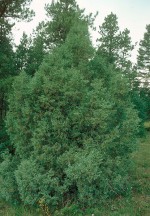 A native of dry, rocky ridges in the eastern foothills of the Rocky Mountains, this small evergreen broad pyramidal tree is a member of the Cypress family, Cupressaceae, that also includes redwoods. It grows 30-40′ tall and has vertical growing branches and medium texture. The red- brown to gray bark is shredding and provides year round interest. The leaves are scale-like and either deep green or blue-green. Male and female cones are usually produced on different trees with the female cones giving rise to small deep blue berry-like fruits with a whitish bloom that take two year to ripen. Rocky Mountain juniper is a long lived tree, with remains in New Mexico suggesting they were 2,000 years old. In spite of its longevity, this tree in intolerant of wet soils and the heat and humidity of the Deep South. Although it is susceptible to juniper blights and is an alternative host to cedar apple-rust, it is a valuable garden plant and is popular as a specimen, hedge, screen, foundation planting, and in containers. The cultivar ‘Skyrocket’ is very popular because of its columnar upright growth but it is very susceptible to fungal disease and is being superseded by ‘Blue Arrow’ that has more disease resistance. Many cultivars are available offering variety in foliage color, size and shape. The genus name, Juniperus, is the ancient Latin name for the plant. The specific epithet, scopulorum, comes from the Latin word scopulus meaing rock or cliff and refers to the tree’s native habitat.
A native of dry, rocky ridges in the eastern foothills of the Rocky Mountains, this small evergreen broad pyramidal tree is a member of the Cypress family, Cupressaceae, that also includes redwoods. It grows 30-40′ tall and has vertical growing branches and medium texture. The red- brown to gray bark is shredding and provides year round interest. The leaves are scale-like and either deep green or blue-green. Male and female cones are usually produced on different trees with the female cones giving rise to small deep blue berry-like fruits with a whitish bloom that take two year to ripen. Rocky Mountain juniper is a long lived tree, with remains in New Mexico suggesting they were 2,000 years old. In spite of its longevity, this tree in intolerant of wet soils and the heat and humidity of the Deep South. Although it is susceptible to juniper blights and is an alternative host to cedar apple-rust, it is a valuable garden plant and is popular as a specimen, hedge, screen, foundation planting, and in containers. The cultivar ‘Skyrocket’ is very popular because of its columnar upright growth but it is very susceptible to fungal disease and is being superseded by ‘Blue Arrow’ that has more disease resistance. Many cultivars are available offering variety in foliage color, size and shape. The genus name, Juniperus, is the ancient Latin name for the plant. The specific epithet, scopulorum, comes from the Latin word scopulus meaing rock or cliff and refers to the tree’s native habitat.
Type: Evergreen small tree
Outstanding Feature: Adaptability
Form: Pyramidal
Growth Rate: Slow to moderate
Bloom: Male and female cones are produced on separate trees; female cones produce blue berry-like fruit that take two years to ripen.
Size: 30-40’ H x 3-12’ W
Light: Full sun
Soil: Average, dryish, well-drained; does not tolerate wet soil
Hardiness: Zones 4-8
Care: Low maintenance
Pests and Diseases: Susceptible to blight, canker, aphids, bagworms, spider mites, root rots, twig borers, webworms and scale.
Propagation: Cuttings
Outstanding Selections:

-
- ‘Blue Arrow’ (upright, columnar, disease resistant)

-
- ‘Blue Creeper’ (low, speading; blue foliage color that intensifies in winter)

-
- ‘Moonglow’ (dense, pyramidal with little pruning)

- ‘Tolleson’s Blue Weeping’ (foliage in silvery blue stripe)
- Photo Credit: Dave-Powell-USDA-Forest-Service
